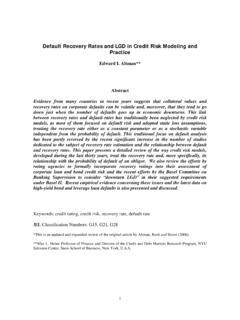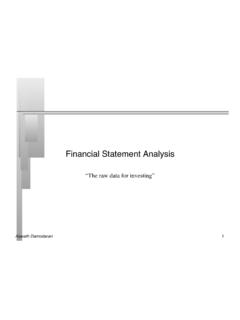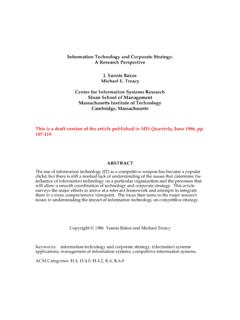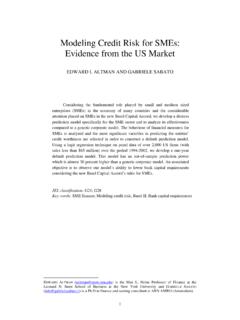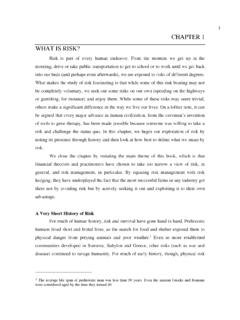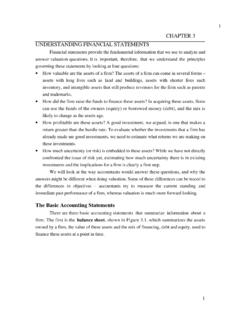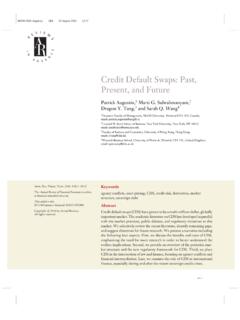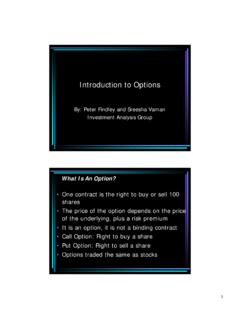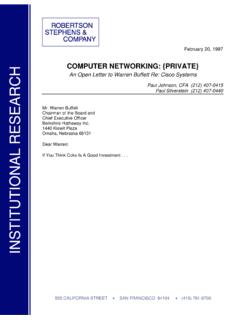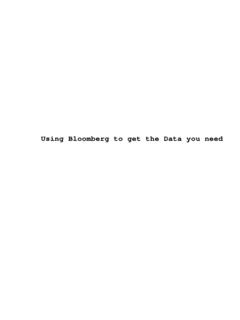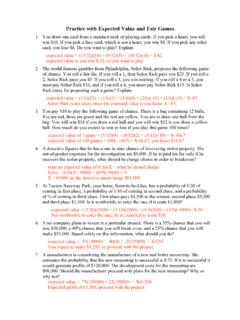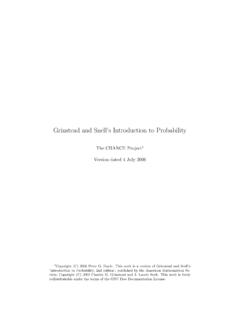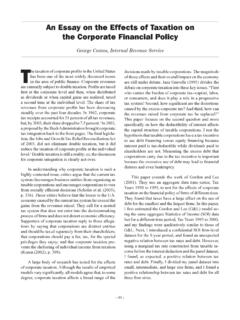Transcription of Estimating Risk free Rates Aswath Damodaran Stern School ...
1 Estimating Risk free Rates Aswath Damodaran Stern School of Business 44 West Fourth Street New York, NY 10012. Estimating Risk free Rates Models of risk and return in finance start off with the presumption that there exists a risk free asset, and that the expected return on that asset is known. The expected return on a risky asset is then estimated as the risk free rate ( , the expected return on the risk free asset) plus an expected risk premium. In practice, however, there are two major issue that we have to consider when Estimating risk free Rates .
2 The first relates to the definition of a risk free security, and the characteristics such a security needs to possess. The second applies when there are no risk free assets, and examines how best to estimate a risk free rate under these conditions. We attempt to deal with both these issues in this paper. The Risk free Rate Most risk and return models in finance start off with an asset that is defined as risk free , and use the expected return on that asset as the risk free rate. The expected returns on risky investments are then measured relative to the risk free rate, with the risk creating an expected risk premium that is added on to the risk free rate.
3 But what makes an asset risk free ? And what do we do when we cannot find such an asset? These are the questions that we will deal with in this paper. What is a risk free asset? To understand what makes an asset risk free , let us go back to how risk is measured in finance. Investors who buys assets have a return that they expect to make over the time horizon that they will hold the asset. The actual returns that they make over this holding period may by very different from the expected returns, and this is where the risk comes in.
4 Risk in finance is viewed in terms of the variance in actual returns around the expected return. For an investment to be risk free in this environment, then, the actual returns should always be equal to the expected return. To illustrate, consider an investor with a 1-year time horizon buying a 1-year Treasury bill (or any other default- free one-year bond) with a 5% expected return. At the end of the 1-year holding period, the actual return that this investor would have on this investment will always be 5%, which is equal to the expected return.
5 The return distribution for this investment is shown in Figure 1. Figure 1: Returns on a Riskfree Investment Probability = 1. expected Return Returns This investment is risk free because there is no variance around the expected return. Requirements for an Asset to be Risk free Under what conditions will the actual returns on an investment be equal to the expected returns? In our view, there are two basic conditions that have to be met. The first is that there can be no default risk. Essentially, this rules out any security issued by a private firm, since even the largest and safest firms have some measure of default risk.
6 The only securities that have a chance of being risk free are government securities, not because governments are better run than corporations, but because they control the printing of currency. At least in nominal terms, they should be able to fulfil their promises. Even this assumption, straightforward though it might seem, does not always hold up, especially when governments refuse to honor claims made by previous regimes and when they borrow in currencies other than their own. There is a second condition that riskless securities need to fulfil that is often forgotten.
7 For an investment to have an actual return equal to its expected return, there can be no reinvestment risk. To illustrate this point, assume that you are trying to estimate the expected return over a five-year period, and that you want a risk free rate. A. six-month treasury bill rate, while default free , will not be risk free , because there is the reinvestment risk of not knowing what the treasury bill rate will be in six months. Even a 5-year treasury bond is not risk free , since the coupons on the bond will be reinvested at Rates that cannot be predicted today.
8 The risk free rate for a five-year time horizon has to be the expected return on a default- free (government) five-year zero coupon bond. This clearly has painful implications for anyone doing corporate finance or valuation, where expected returns often have to be estimated for periods ranging from one to ten years. A. purist's view of risk free Rates would then require different risk free Rates for each period, and different expected returns. As a practical compromise, however, it is worth noting that the present value effect of using year-specific risk free Rates tends to be small for most well-behaved1 term structures.
9 In these cases, we could use a duration matching strategy, where the duration of the default- free security used as the risk free asset is matched up to the duration2 of the cash flows in the analysis. If, however, there are very large differences, in either 1. By well behaved term structures, I would include a normal upward sloping yield curve, where long term Rates are at most 2-3% higher than short term Rates . 2. In investment analysis, where we look at projects, these durations are usually between 3 and 10 years.
10 In valuation, the durations tend to be much longer, since firms are assumed to have infinite lives. The duration direction, between short term and long term Rates , it does pay to stick with year-specific risk free Rates in computing expected returns. The Practical Implications when a Default- free Entity exists In most developed markets, where the government can be viewed as a default free entity, at least when it comes to borrowing in the local currency, the implications are simple. When doing investment analysis on longer term projects or valuation, the risk free rate should be the long term government bond rate.
